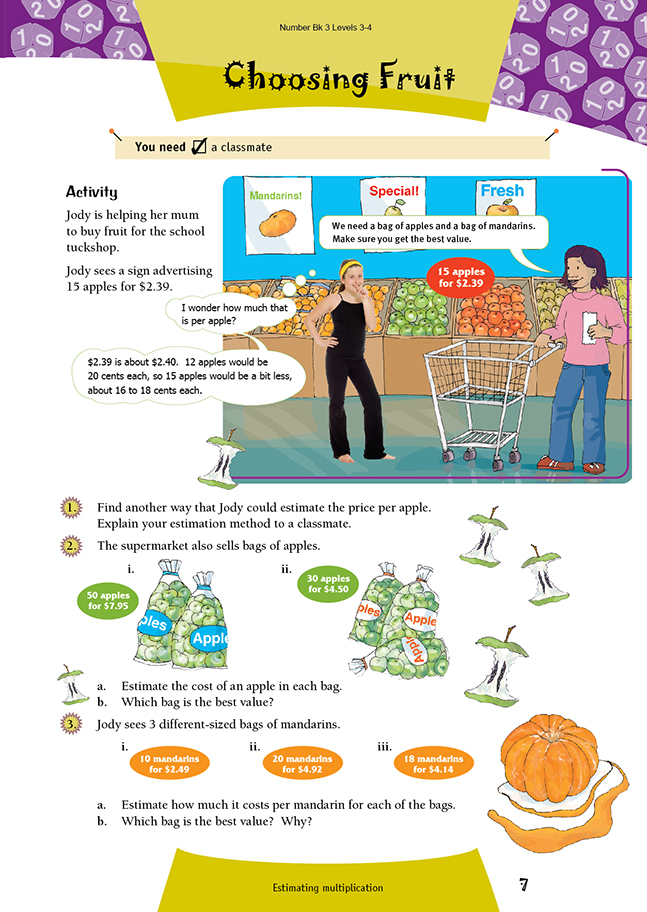This is a level 4 number activity from the Figure It Out series. It relates to Stage 7 of the Number Framework.
A PDF of the student activity is included.
Click on the image to enlarge it. Click again to close. Download PDF (484 KB)
use proportions to solve problems
FIO, Level 3-4, Number, Book 3, Choosing Fruit, page 7
A classmate
The problems in this activity also involve rates and require students to have strong multiplicative reasoning skills (advanced multiplicative stage of the Number Framework).
An estimate is a number that seems reasonable when it is not possible or necessary in the circumstances to know the exact amount. The estimation required in this activity involves strategies such as sensible rounding of numbers to those that can be manipulated mentally (for example, $7.95 can be rounded to $8.00) and recognising relationships between numbers (for example, 10 mandarins is half the quantity of 20 mandarins). Jody also needs to compare the same fruit in different-sized bags. Reducing prices to their unit value allows valid comparison (for example, 10 at $2.49 gives a unit value of just under 25 cents per piece of fruit, whereas 5 at $1.50 gives a unit value of 30 cents per piece). Sometimes comparisons other than unit values are more efficient. For example, in question 2, the price of 10 apples could be calculated to compare the two deals.
For question 1, four alternative ways of estimating the price per apple are provided in the Answers. The fourth method requires a reasonable degree of number sense.
Some different ways of estimating the cost of an apple in each bag in question 2 are also provided in the Answers. Again, mentally calculating the cost of 10 apples is a good strategy to use. As an extension, ask the students to calculate what a bag with 50 apples would cost at this price and what the saving would be compared with the price of the first lot of apples.
Note that, in the mental calculations for 10 apples, we are using the strategy for dividing by 10 that was discussed in Place the Digits (page 1 of the students’ book). If 10 apples cost $1.60, the price of 1 apple can be found by shifting each of the digits one column to the right (so that $1.60 becomes $0.16). This strategy can also be used with question 3.
In question 3, the students should be able to estimate the cost per mandarin in the first 2 bags. Estimating the cost per mandarin in the bag containing 18 mandarins for $4.14 poses a bigger challenge. One possibility would be to say that $4.14 is close to $4.20, so 3 mandarins would be 1/6 of $4.20 (70 cents) and 1 mandarin would be 1/3 of 70 cents, which is about 23 cents. This estimation is based on a number of mental calculations. The second method outlined in the Answers (using logical reasoning) is just as valid in terms of estimation. It is important that students are
not afraid to give an estimate in case it is “wrong”. The objective is to learn to give sensible estimates that can be justified.
As an extension, have the students calculate the cost of a bag of 10 mandarins at this cheapest rate of 23 cents per mandarin and a 20-mandarin bag at the same rate. They could also calculate the cost of a box of 100 mandarins at this rate and the amount they would save in comparison with the most expensive option.
Answers to Activity
1. Methods will vary. Some possible methods are:
i. 10c each would be $1.50; 5c each would be $0.75; 15c each would be $2.25; so 1 apple must be a bit more: about 16c.
ii. 15 at 20c equals $3.00: too big; 15 at 10c equals $1.50: too small; so 1 apple should be just over halfway between 16c and 17c.
iii. $2.39 is about $2.40, so you’d get 5 for about 80c, which means that 1 would be about 16c.
iv. 10 apples is 2/3 of 15; 2/3 of $2.40 is $1.60; $1.60 ÷ 10 = 16c.
2. a. Estimates will vary. For example:
i. 16c. ($7.95 is about $8.00, so 5 would be about 80c; 10 would be about $1.60,
so 1 apple would be about 16c.)
ii. 15c. (If they were 10c, 30 would be $3.00. If they were 20c, 30 would be
$6.00. $4.50 is halfway between, so they are about 15c each.)
b. 30 for $4.50 is the cheaper of the 2 bags.
3. a. Sensible estimates would be:
i. 25c each
ii. 25c each. (If you were calculating this exactly, without rounding, they would
be slightly cheaper than i.)
iii. 23c each. (One way to estimate this is to work on the cost of 3 mandarins.
Another way is to reason that you would pay 78c for the extra 2 mandarins in
bag ii, so the mandarins in bag iii must be less than 25c each, and 23c would
be a fair estimate.)
b. 18 for $4.14 is the cheapest bag because each mandarin is 23c. The dearest is 10 for $2.49 because each mandarin in this bag is nearly 25c.
